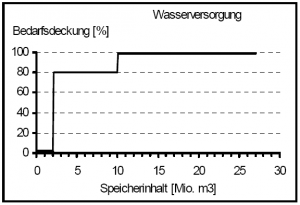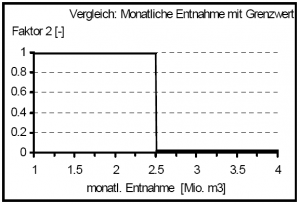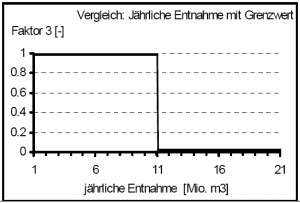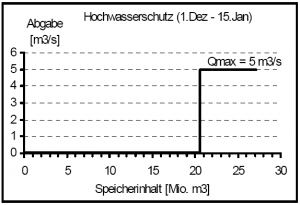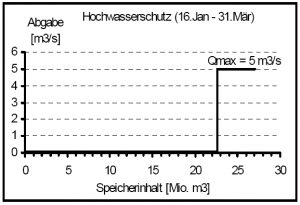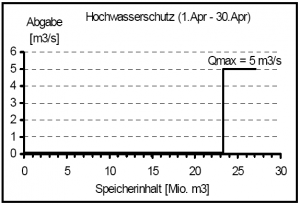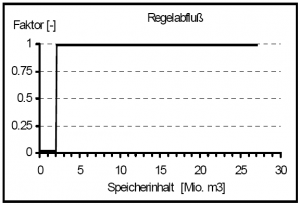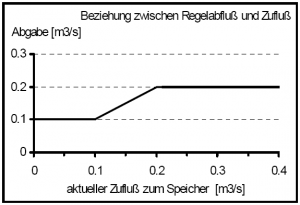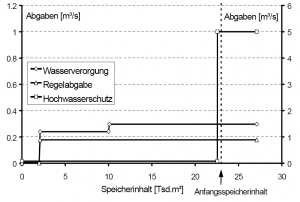Anwendungsbeispiel: Umsetzung eines Betriebsplans/en: Unterschied zwischen den Versionen
Ferrao (Diskussion | Beiträge) (Die Seite wurde neu angelegt: „Validity period: Jan. 1 - Dec. 31.“) |
Keine Bearbeitungszusammenfassung |
||
| (156 dazwischenliegende Versionen von 3 Benutzern werden nicht angezeigt) | |||
| Zeile 3: | Zeile 3: | ||
{{Navigation|vorher=Berechungsschema/ Implementierung der Betriebsregeln|hoch=Betriebsregelkonzept|nachher=Begriffsdefinitionen}} | {{Navigation|vorher=Berechungsschema/ Implementierung der Betriebsregeln|hoch=Betriebsregelkonzept|nachher=Begriffsdefinitionen}} | ||
Taking the [https://de.wikipedia.org/wiki/Wehebachtalsperre Wehebach-Dam] as an example of use, the implementation of an operating plan in accordance with applying laws is illustrated. | |||
The Wehebach-Dam is a multi-purpose | The Wehebach-Dam is a multi-purpose storage used for water supply and flood protection. In addition, a standard discharge of 100 l/s to the downstream watercourse is to be maintained. The operator of the dam is the [http://www.wver.de Water association Eifel-Rur]. The operation responsibilities include the drinking water supply of the greater Aachen area, the northern Eifel region and the supply of service water for several industrial companies. The catchment area of the dam is 43.61 km², the average annual inflow is 21 million m³, and the storage capacity is 119.3%. Built as a rockfill dam, the construction of the storage was completed in 1983. | ||
The following operating plan was drawn up for the Wehebach-Dam: | The following operating plan was drawn up for the Wehebach-Dam: | ||
| Zeile 11: | Zeile 11: | ||
* ''Characteristics of the dam:'' | * ''Characteristics of the dam:'' | ||
: | :Max. content at crest level: 27.1M m³ | ||
: | :Capacity to the spillway: 25.06M m³ | ||
: | :Capacity level (normal water level): see flood control areas | ||
* '' | * ''Release volume for water supply:'' | ||
The | The storage provides two water supply companies with drinking water. The companies request water via daily demand values. Concerning the water supply, it is set that up to 11 million m³ must be provided annually as drinking water, of which no more than 2.5 million m³ may be discharged each month. | ||
* '' | * ''Standard discharge:'' | ||
The standard discharge is intended to provide a minimum flow downstream of the dam and is set depending on the inflow, as follows: | |||
:{| cellspacing="0" cellpadding="5" | :{| cellspacing="0" cellpadding="5" | ||
| || Inflow || ≥ 200 l/s || → || | | || Inflow || ≥ 200 l/s || → || Standard discharge || = || 200 l/s | ||
|- | |- | ||
| 100 l/s ≤ || Inflow || < 200 l/s || → || | | 100 l/s ≤ || Inflow || < 200 l/s || → || Standard discharge || = || Inflow | ||
|- | |- | ||
| || Inflow || < 100 l/s || → || | | || Inflow || < 100 l/s || → || Standard discharge || = || 100 l/s | ||
|} | |} | ||
Every water resources management year, not later than the end of March, 4 m³/s must be discharged to the downstream watercourse as a flushing wave over a period of 6 hours. | |||
* ''Flood control areas:'' | * ''Flood control areas:'' | ||
To ensure sufficing flood protection, a time-variable pool-based flood level is defined. The lower limit of the flood control areas is defined as the capacity level. | |||
:{| cellspacing="0" cellpadding="5" | :{| cellspacing="0" cellpadding="5" | ||
| 1.10. - 31.10. ||Flood | | 1.10. - 31.10. || Flood control area || = 1.00M m³ || Capacity level || = 24.06M m³ | ||
|- | |- | ||
| 1.11. - 30.11. || Flood | | 1.11. - 30.11. || Flood control area || = 2.75M m³ || Capacity level || = 22.31M m³ | ||
|- | |- | ||
| 1.12. - 15.1. || Flood | | 1.12. - 15.1. || Flood control area || = 4.50M m³ || Capacity level || = 20.56M m³ | ||
|- | |- | ||
| 16.1. - 31.3. || Flood | | 16.1. - 31.3. || Flood control area || = 2.50M m³ || Capacity level || = 22.56M m³ | ||
|- | |- | ||
| 1.4. - 30.4. || Flood | | 1.4. - 30.4. || Flood control area || = 1.75M m³ || Capacity level || = 23.31M m³ | ||
|- | |- | ||
| 1.5. - 30.9. || Flood | | 1.5. - 30.9. || Flood control area || = 1.00M m³ || Capacity level || = 24.06M m³ | ||
|} | |} | ||
Clearance of flood control areas is done at the maximal permitted discharge. | |||
* '' | * ''Maximal permitted discharge:'' | ||
As long as the normal water level has not yet been reached, no more than 5 m³/s may be discharged to the downstream watercourse. | |||
If the normal | If the normal water level of the dam is exceeded and the inflow exceeds the maximum discharge of 5 m³/s, no more than 5 m³/s may be discharged from the bottom outlet. Additional inflow is to be discharged via the spillway. | ||
* '' | * ''Capacity curve of the spillway:'' | ||
The characteristic curve is given | The characteristic curve is given as a X-Y curve with interpolation points. | ||
The realization of the operating plan considering the terminology described above, first requires the identification of all expectations and uses for the dam and a definition of the ''discharge functions''. The following information is provided only to illustrate the operating plan concept and does not claim to be complete or an accurate representation of actual conditions. | |||
* '''''Use:'' Water supply | * '''''Use:''' Water supply'' | ||
:{| cellspacing="0" cellpadding="5" | :{| cellspacing="0" cellpadding="5" | ||
| colspan="2" | <u> | | colspan="2" | <u>Temporal dependency:</u> || Constant annualized discharge function, variable demand | ||
|- | |- | ||
| colspan="2" | <u> | | colspan="2" | <u>External dependencies:</u> || Yes | ||
|- | |- | ||
| || 1. | | || 1. Current water demand [m³/s]: || Factor1 (calculation rule: multiplication) | ||
|- | |- | ||
| || 2. | | || 2. Monthly balance of withdrawals: || Factor2 (calculation rule: multiplication) | ||
|- | |- | ||
| || 3. | | || 3. Annual balance of withdrawals: || Factor3 (calculation rule: multiplication) | ||
|- | |- | ||
| colspan="2" valign="top" | <u> | | colspan="2" valign="top" | <u>Discharge per time step:</u> || Calculation of the use 'water supply' with:<br/> | ||
<code> | <code>Discharge = Factor1 × Factor2 × Factor3 × f(Storage volume)</code> | ||
|} | |} | ||
| Zeile 87: | Zeile 87: | ||
! width="200" | Discharge functions | ! width="200" | Discharge functions | ||
|- | |- | ||
| <u> | | <u>Fulfillment of demand [%]:</u> | ||
Period of validity: Jan. 1 - Dec. 31. | |||
Explanation: | Explanation: Starting from a storage capacity of < 10 million m³, the fulfillment of demand is reduced to 80%. If the storage volume falls below 2 million m³, no more water is withdrawn. | ||
| align="center" | [[Bild:Theorie_Bsp01.png|thumb|none]] | | align="center" | [[Bild:Theorie_Bsp01.png|thumb|none]] | ||
|- style="background-color:#CCCCCC;" | |- style="background-color:#CCCCCC;" | ||
! Conditions !! System | ! Conditions !! System State Functions | ||
|- | |- | ||
| <u>Actual water demand [m³/s]:</u> | | <u>Actual water demand [m³/s]:</u> | ||
| Zeile 104: | Zeile 103: | ||
Time reference: current value | Time reference: current value | ||
Calculation rule: | Calculation rule: multiplication | ||
| align="center" | | | align="center" | No function necessary | ||
|- | |- | ||
| <u>Monthly balance of | | <u>Monthly balance of discharge [-]:</u> | ||
(Factor 2) | (Factor 2) | ||
Time reference: | Time reference: monthly balance | ||
Period of validity: Jan. 1 - Dec. 31. | |||
Limit value: 2.5M m³ | |||
Calculation rule: multiplication | |||
| align="center" | [[Bild:Theorie_Bsp02.png|thumb|none]] | | align="center" | [[Bild:Theorie_Bsp02.png|thumb|none]] | ||
|- | |- | ||
| <u> | | <u>Annual balance of discharge [-]:</u> | ||
( | (Factor 3) | ||
Time reference: annual balance | |||
Period of validity: Jan. 1 - Dec. 31. | |||
Limit value: 11.0M m³ | |||
Calculation rule: multiplication | |||
| [[Bild:Theorie_Bsp03.png|thumb|none]] | | [[Bild:Theorie_Bsp03.png|thumb|none]] | ||
|} | |} | ||
* ''''' | * '''''Use:''' Flood Protection'' | ||
:{| cellspacing="0" cellpadding="5" | :{| cellspacing="0" cellpadding="5" | ||
| <u> | | <u>Time dependency:</u> || Yes | ||
|- | |- | ||
| <u> | | <u>External dependencies:</u> || No | ||
|- | |- | ||
| valign="top" | <u> | | valign="top" | <u>Discharge per time step:</u> || The use 'flood protection' is given directly as a function of the date. | ||
<code> | <code>Discharge = f(storage volume)</code> | ||
|} | |} | ||
:{| class="wikitable" cellspacing="0" cellpadding="5" border="1" | :{| class="wikitable" cellspacing="0" cellpadding="5" border="1" | ||
|- style="background-color:#CCCCCC;" | |- style="background-color:#CCCCCC;" | ||
! width="300" | | ! width="300" | Conditions | ||
! width="200" | | ! width="200" | Discharge Functions | ||
|- | |- | ||
| | | Period of validity: Dec. 1 - Jan. 15. | ||
Maximal permitted discharge: 5 m³/s | |||
Capacity level: 20.56M m³ | |||
| [[Bild:Theorie_Bsp04.png|thumb|none]] | | [[Bild:Theorie_Bsp04.png|thumb|none]] | ||
|- | |- | ||
| | |Period of validity: 16 Jan - 31 March | ||
Maximal permitted discharge: 5 m³/s | |||
Capacity level: 22.56M m³ | |||
| [[Bild:Theorie_Bsp05.png|thumb|none]] | | [[Bild:Theorie_Bsp05.png|thumb|none]] | ||
|- | |- | ||
| | | Period of validity: April 1 - April 30 | ||
Maximal permitted discharge: 5 m³/s | |||
Capacity level: 23.31M m³/s | |||
| [[Bild:Theorie_Bsp06.png|thumb|none]] | | [[Bild:Theorie_Bsp06.png|thumb|none]] | ||
|- | |- | ||
| colspan="2" | | | colspan="2" | For the remaining periods, the discharge functions are analogous. | ||
|} | |} | ||
* ''''' | * '''''Use:''' Standard discharge'' | ||
:{| cellspacing="0" cellpadding="5" | :{| cellspacing="0" cellpadding="5" | ||
| colspan="2" | <u> | | colspan="2" | <u>Time dependency:</u> || Yes | ||
|- | |- | ||
| colspan="2" | <u> | | colspan="2" | <u>External dependencies:</u> || Yes | ||
|- | |- | ||
| || 1. | | || 1. Current inflow {m³/s]: || Factor 1 (calculation rule: multiplication) | ||
|- | |- | ||
| colspan="2" valign="top" | <u> | | colspan="2" valign="top" | <u>Discharge per time step:</u> || Calculation of the use 'standard discharge' with:<br/> | ||
<code> | <code>Discharge = Factor × f(storage volume)</code> | ||
|} | |} | ||
:{| class="wikitable" cellspacing="0" cellpadding="5" border="1" | :{| class="wikitable" cellspacing="0" cellpadding="5" border="1" | ||
|- style="background-color:#CCCCCC;" | |- style="background-color:#CCCCCC;" | ||
! width="300" | | ! width="300" | Conditions | ||
! width="200" | | ! width="200" | Discharge Functions | ||
|- | |- | ||
| <u> | | <u>Factor standard discharge [-]:</u> | ||
Period of validity: Jan. 1 - Dec. 31. | |||
Explanation: If the storage volume declines below 2 million m³, a standard discharge is no longer maintained. | |||
| [[Bild:Theorie_Bsp07.png|thumb|none]] | | [[Bild:Theorie_Bsp07.png|thumb|none]] | ||
|- style="background-color:#CCCCCC;" | |- style="background-color:#CCCCCC;" | ||
! | ! Conditions | ||
! | ! System State Functions | ||
|- | |- | ||
| <u> | | <u>Current inflow [m³/s]:</u> | ||
( | (Factor 1) | ||
Period of validity: Jan. 1 - Dec. 31. | |||
Maximal permitted discharge: 5 m³/s | |||
Explanation: If the inflow exceeds 0.2 m³/s, a discharge of 0.2 m³/s continues. | |||
| [[Bild:Theorie_Bsp08.png|thumb|none]] | | [[Bild:Theorie_Bsp08.png|thumb|none]] | ||
|} | |} | ||
| Zeile 223: | Zeile 220: | ||
[[Bild:Theorie_Abb26.png|thumb|Abbildung 26: Skalierte Abgabenfunktionen]] | [[Bild:Theorie_Abb26.png|thumb|Abbildung 26: Skalierte Abgabenfunktionen]] | ||
For a selected time and an assumed initial storage volume of S<sub>0</sub> = 23K m³, all relations are plotted in [[:Bild:Theorie_Abb26.png|Abbildung 26]]. For illustration purposes, a different y-axis scale is chosen for the flood control function. | |||
{| class="wikitable" cellspacing="0" cellpadding="5" border="1" | {| class="wikitable" cellspacing="0" cellpadding="5" border="1" | ||
|- style="background-color:#CCCCCC;" | |- style="background-color:#CCCCCC;" | ||
! | ! Parameters !! Defaults !! Affected Parameters: | ||
|- | |- | ||
| | | Time || January 30 || flood protection, water supply. (Factor1, Factor2) | ||
|- | |- | ||
| | | Initial storage volume || 23M m³ || all discharge functions | ||
|- | |- | ||
| | | Average daily inflow || 0.180 m³/s || standard discharge | ||
|- | |- | ||
| | | Average water demand || 0.300 m³/s || discharge for water supply | ||
|- | |- | ||
| | | Discharge for water supply since 1.Jan. || 0.750M m³ || discharge for water supply | ||
|} | |} | ||
Aktuelle Version vom 30. August 2021, 12:41 Uhr
Taking the Wehebach-Dam as an example of use, the implementation of an operating plan in accordance with applying laws is illustrated.
The Wehebach-Dam is a multi-purpose storage used for water supply and flood protection. In addition, a standard discharge of 100 l/s to the downstream watercourse is to be maintained. The operator of the dam is the Water association Eifel-Rur. The operation responsibilities include the drinking water supply of the greater Aachen area, the northern Eifel region and the supply of service water for several industrial companies. The catchment area of the dam is 43.61 km², the average annual inflow is 21 million m³, and the storage capacity is 119.3%. Built as a rockfill dam, the construction of the storage was completed in 1983.
The following operating plan was drawn up for the Wehebach-Dam:
- Characteristics of the dam:
- Max. content at crest level: 27.1M m³
- Capacity to the spillway: 25.06M m³
- Capacity level (normal water level): see flood control areas
- Release volume for water supply:
The storage provides two water supply companies with drinking water. The companies request water via daily demand values. Concerning the water supply, it is set that up to 11 million m³ must be provided annually as drinking water, of which no more than 2.5 million m³ may be discharged each month.
- Standard discharge:
The standard discharge is intended to provide a minimum flow downstream of the dam and is set depending on the inflow, as follows:
Inflow ≥ 200 l/s → Standard discharge = 200 l/s 100 l/s ≤ Inflow < 200 l/s → Standard discharge = Inflow Inflow < 100 l/s → Standard discharge = 100 l/s
Every water resources management year, not later than the end of March, 4 m³/s must be discharged to the downstream watercourse as a flushing wave over a period of 6 hours.
- Flood control areas:
To ensure sufficing flood protection, a time-variable pool-based flood level is defined. The lower limit of the flood control areas is defined as the capacity level.
1.10. - 31.10. Flood control area = 1.00M m³ Capacity level = 24.06M m³ 1.11. - 30.11. Flood control area = 2.75M m³ Capacity level = 22.31M m³ 1.12. - 15.1. Flood control area = 4.50M m³ Capacity level = 20.56M m³ 16.1. - 31.3. Flood control area = 2.50M m³ Capacity level = 22.56M m³ 1.4. - 30.4. Flood control area = 1.75M m³ Capacity level = 23.31M m³ 1.5. - 30.9. Flood control area = 1.00M m³ Capacity level = 24.06M m³
Clearance of flood control areas is done at the maximal permitted discharge.
- Maximal permitted discharge:
As long as the normal water level has not yet been reached, no more than 5 m³/s may be discharged to the downstream watercourse.
If the normal water level of the dam is exceeded and the inflow exceeds the maximum discharge of 5 m³/s, no more than 5 m³/s may be discharged from the bottom outlet. Additional inflow is to be discharged via the spillway.
- Capacity curve of the spillway:
The characteristic curve is given as a X-Y curve with interpolation points.
The realization of the operating plan considering the terminology described above, first requires the identification of all expectations and uses for the dam and a definition of the discharge functions. The following information is provided only to illustrate the operating plan concept and does not claim to be complete or an accurate representation of actual conditions.
- Use: Water supply
Temporal dependency: Constant annualized discharge function, variable demand External dependencies: Yes 1. Current water demand [m³/s]: Factor1 (calculation rule: multiplication) 2. Monthly balance of withdrawals: Factor2 (calculation rule: multiplication) 3. Annual balance of withdrawals: Factor3 (calculation rule: multiplication) Discharge per time step: Calculation of the use 'water supply' with:
Discharge = Factor1 × Factor2 × Factor3 × f(Storage volume)
Conditions Discharge functions Fulfillment of demand [%]: Period of validity: Jan. 1 - Dec. 31.
Explanation: Starting from a storage capacity of < 10 million m³, the fulfillment of demand is reduced to 80%. If the storage volume falls below 2 million m³, no more water is withdrawn.
Conditions System State Functions Actual water demand [m³/s]: (Factor 1)
Time reference: current value
Calculation rule: multiplication
No function necessary Monthly balance of discharge [-]: (Factor 2)
Time reference: monthly balance
Period of validity: Jan. 1 - Dec. 31.
Limit value: 2.5M m³
Calculation rule: multiplication
Annual balance of discharge [-]: (Factor 3)
Time reference: annual balance
Period of validity: Jan. 1 - Dec. 31.
Limit value: 11.0M m³
Calculation rule: multiplication
- Use: Flood Protection
Time dependency: Yes External dependencies: No Discharge per time step: The use 'flood protection' is given directly as a function of the date. Discharge = f(storage volume)
Conditions Discharge Functions Period of validity: Dec. 1 - Jan. 15. Maximal permitted discharge: 5 m³/s
Capacity level: 20.56M m³
Period of validity: 16 Jan - 31 March Maximal permitted discharge: 5 m³/s
Capacity level: 22.56M m³
Period of validity: April 1 - April 30 Maximal permitted discharge: 5 m³/s
Capacity level: 23.31M m³/s
For the remaining periods, the discharge functions are analogous.
- Use: Standard discharge
Time dependency: Yes External dependencies: Yes 1. Current inflow {m³/s]: Factor 1 (calculation rule: multiplication) Discharge per time step: Calculation of the use 'standard discharge' with:
Discharge = Factor × f(storage volume)
Conditions Discharge Functions Factor standard discharge [-]: Period of validity: Jan. 1 - Dec. 31.
Explanation: If the storage volume declines below 2 million m³, a standard discharge is no longer maintained.
Conditions System State Functions Current inflow [m³/s]: (Factor 1)
Period of validity: Jan. 1 - Dec. 31.
Maximal permitted discharge: 5 m³/s
Explanation: If the inflow exceeds 0.2 m³/s, a discharge of 0.2 m³/s continues.
For a selected time and an assumed initial storage volume of S0 = 23K m³, all relations are plotted in Abbildung 26. For illustration purposes, a different y-axis scale is chosen for the flood control function.
| Parameters | Defaults | Affected Parameters: |
|---|---|---|
| Time | January 30 | flood protection, water supply. (Factor1, Factor2) |
| Initial storage volume | 23M m³ | all discharge functions |
| Average daily inflow | 0.180 m³/s | standard discharge |
| Average water demand | 0.300 m³/s | discharge for water supply |
| Discharge for water supply since 1.Jan. | 0.750M m³ | discharge for water supply |
